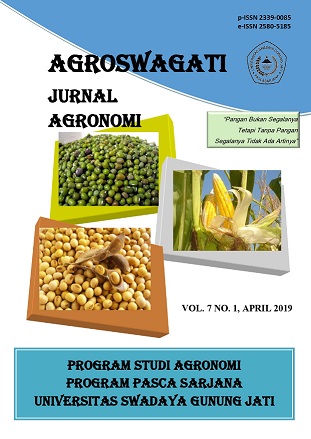ADOPSI VARIETAS UNGGUL BARU PADI DI LAHAN RAWA
DOI:
https://doi.org/10.33603/agroswagati.v7i1.2850Keywords:
Swampy swamp area, Pasangsurut swamp, New superior varieties (VUB) of riceAbstract
This research was conducted using a survey method carried out in two districts in the South Sumatra region namely Ogan Ilir and Banyuasin starting in March 2019. Ogan Ilir Regency represents the lebak swamp area while Banyuasin represents the Pasangsurut swamp area. The selection of provinces is determined by purposive sampling, which is chosen provinces that have a fairly large swampy land. Data collected includes: (1) Characteristics of respondents (age, sex, education, land area / arable land, (2) Reasons for choosing a vub to plant, (3) source of seeds and seed classes planted, and (4) data and information other relevant to the purpose of the study.This study aims to identify the level of adoption and development of new superior varieties (VUB) of rice in swamps and identify the reasons for farmers in adopting and planting VUBs.From the results of the study revealed that Ciherang is a common variety planted by respondents in Ogan Ilir, while IR 42 is a variety commonly planted in Banyuasin, transplanting planting is done twice by seedlings, generally done by respondents in Ogan Ilir, while seed planting is directly carried out by respondents in Banyuasin, most respondents in Ogan Ilir are not familiar with Inpara varieties, varieties planted in the two districts are generally not labeled.Some of the reasons cited by farmers grow varieties between high production, short service life, and pest resistance data Distribution of varieties in South Sumatra shows that Ciherang is still the dominant variety, while Inpara has not been recorded in the data held by local agencies.References
Anonim. 2017. Deskripsi varietas Unggul Baru Padi. Badan Litbang Pertanian-Kementerian Pertanian
Anonim. 2018. Data Sebaran Varietas Padi. BPSB Sumatera Selatan
Adri dan Endrizal. 2015. Tingkat Adopsi Petani Terhadap Varietas Unggul Baru Padi di Provinsi Jambi. Prosiding Seminar Nasional 2014. Balai Besar Penelitian Tanaman Padi, Badan Litbang Pertanian. Buku 2.
Herman dan Rina Y. 2017. Karakteristik Sosial Ekonomi Petani di Lahan rawa. Dalam Agroekologi Rawa. PT RajaGrafika Persada – Depok.
Irawan B., 2004. Dinamika produktivitas dan kualitas budidaya padi sawah. Ekonomi Padi dan Beras Indonesia. Badan Penelitian dan Pengembangan Pertanian, pp:179-200.
Las, I., Suprihatno, B., Daradjat, A.A., Suwarno, Abdullah B., Satoto, 2004. Inovasi Teknologi Varietas Unggul Padi: Perkembangan, Arah, dan Strategi ke Depan., Ekonomi Padi dan Beras Indonesia. Badan Penelitian dan Pengembangan Pertanian, pp:375-396.
Musyafak A, dan Ibrahim T.M. 2005. Strategi dan Percepatan Adopsi dan Difusi Inovasi Pertanian Mendukung Prima Tani. Analisis kebijakan Pertanian Vol 3 No 1. Maret 2005.
Sayuti, Djulin, A.M., Iqbal, M., 1998. Analisis pendekatan penyuluhan, pembentukan persepsi petani serta pengaruhnya terhadap adopsi teknologi inovasi: Kasus introduksi teknologi baru program SUTPA di Propinsi Jawa Timur dan Lampung. Prosiding Dinamika Ekonomi Pedesaan dan Peningkatan Daya Saing Sektor Pertanian. Buku II. Pusat Penelitian Sosial Ekonomi Pertanian, Badan Litbang Pertanian.
Wahyuni S., Ruskandar, A., Mulsanti, I.W., 2008. Peran produsen benih dalam diseminasi varietas unggul padi di Jawa Barat,. Prosiding Seminar Apresiasi Hasil Penelitian Padi Menunjang P2BN. Buku 2. Balai Besar Penelitian Tanaman Padi, pp:882-889.
Downloads
Published
Issue
Section
License
The Authors submitting a manuscript do so on the understanding that if accepted for publication, copyright of the article shall be assigned to Jurnal AGROSWAGATI, Sekolah Pascasarjana Ilmu Pertanian. Universitas Swadaya Gunung Jati as publisher of the journal. Copyright encompasses rights to reproduce and deliver the article in all form and media, including reprints, photographs, microfilms, and any other similar reproductions, as well as translations.
Jurnal AGROSWAGATI, Universitas Swadaya Gunung Jati and the Editors make every effort to ensure that no wrong or misleading data, opinions or statements be published in the journal. In any way, the contents of the articles and advertisements published in Jurnal AGROSWAGATIare the sole responsibility of their respective authors and advertisers.

